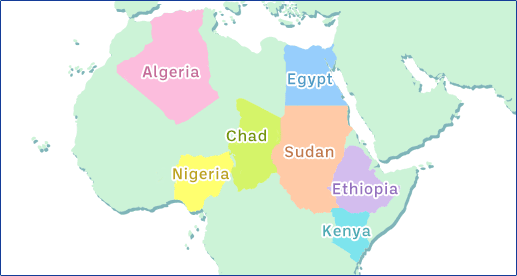
Yogurt in Africa
Algeria / Egypt / Ethiopia / Kenya / Sudan / Chad / Nigeria

Algeria
Dairy farming is actively practiced along the coast of the Mediterranean Sea and south of the Ahaggar Mountains. In those regions, people have traditionally consumed takammart, which is prepared by mixing goat or sheep milk with previously-produced left-over curds, letting it sit to ferment, then straining it to get the curds, kneading by hand to further eliminate the whey, letting the curds dry in the sun for a couple of days, bringing them into the shade to dry further, and placing them in leather sacks for storage. There is another variation of fermented milk that is part of the country’s traditions called “aoules,” which is prepared by curdling milk through natural fermentation, churning it in a leather sack to remove the butter, heating up the remaining buttermilk to turn it into curds, forming them into flat sheets, and letting them dry in the sun.
Egypt
The most heavily consumed cultured milk in Egypt is zabady (laban zabady), which is a yogurt that is fermented with L. bulgaricus and S. thermophilus; the one made from buffalo milk is especially popular. In farming villages, people make laban rayeb themselves, by placing fresh milk in earthenware to ferment naturally, and then removing the cream that rises to the surface. People eat laban rayeb as is and also use it to make cheese. Laban zeer is an Egyptian condensed fermented milk, which is prepared by placing fresh milk into a leather sack to ferment, shaking it up to make buttermilk by removing the butter, placing it in earthenware (called “zeer”) to let the water evaporate, and finally adding salt; the beverage is typically consumed during the hot months of May through July. It is diluted with water before consumption to alleviate the effects of the heat, and is called laban rayeb. People in Egypt also use laban rayeb and laban zeer in cooking, by mixing either of them with wheat flour or cooked wheat and boiling it, and then letting it dry in the sun. This dish is called kishk, which can be produced in bulk and be conveniently eaten throughout the year simply by diluting with water.
Ethiopia
Ethiopia has its own version of fermented milk that is part of its traditions, called “ergo.” It is prepared by naturally fermenting milk in earthenware that has been smoked inside by burning olive branches, and features a nice smoky flavor. Other cultured dairy products of Ethiopian origin include a buttermilk called “arrera” and a condensed fermented milk called “ititu.”
Kenya
The Masai, one of Kenya’s native tribes, consume fermented milk as a dietary staple, and use calabash fruits, with their interior pre-smoked, as containers in which to ferment milk. A buttermilk locally produced in Kenya is called maziwa lala, which is prepared by naturally fermenting cow milk and removing butter from it. Other yogurt variations unique to Kenya include mursik, which is typically made by fermenting cow milk with herbs in containers, and suusa, which is a naturally fermented camel milk.
Sudan
As the country lies to the south of Egypt, the fermented milks that are specific to Sudan are similar to those made in southern Egypt. As a result, Sudanese people prepare their own versions of zabady and laban rayeb similarly to how they are produced in Egypt. When eating laban rayeb in Sudan, spices are usually added. Also, by adding cream and water to laban rayeb, local people make another variation of yogurt drink called “goubasha,” usually for consumption as a table drink in winter.
Chad
People in Chad make their traditional cultured milk called “rouaba,” by mixing either fermented milk or buttermilk with wheat porridge.
Nigeria
Nigeria has its own traditional cultured milk called "nono," which is prepared by naturally fermenting



















